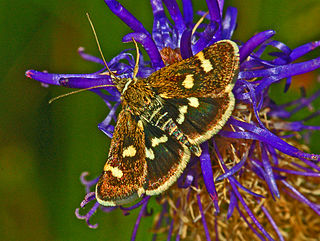
Lampides boeticus, the pea blue, or long-tailed blue, is a small butterfly that belongs to the lycaenids or gossamer-winged family.

The dryandra moth is a species of moth that is considered to be the sole member of the family Carthaeidae. Its closest relatives are the Saturniidae and it bears a resemblance to many species of that family, bearing prominent eyespots on all wings. The common name is derived from the Dryandra shrubs of the genus Banksia, on which the larva of this species feed, and is hence restricted to the south-west of Western Australia where these shrubs grow. Other Grevillea shrubs may also be used as host plants.

Plemyria rubiginata, the blue-bordered carpet, is a moth of the family Geometridae found in Europe and across the Palearctic. The moth was first described by the Austrian lepidopterists Michael Denis and Ignaz Schiffermüller in 1775.

Rhizedra lutosa, the large wainscot or Isle of Wight wainscot, is a species of moth of the family Noctuidae. It is native to the Palearctic realm. It has been introduced into eastern North America and is spreading.

Eurrhypis pollinalis is a species of moth of the family Crambidae. It was described by Michael Denis and Ignaz Schiffermüller in 1775.

Diacrisia sannio, the clouded buff, is a moth of the family Erebidae. The species was first described by Carl Linnaeus in his 1758 10th edition of Systema Naturae. It is found in the Palearctic realm from Ireland to Siberia. It is not found in North Africa. In the Russian Far East, eastern China, Korea, and Japan it is replaced by Diacrisia irene.

Setina irrorella, the dew moth, is a moth of the family Erebidae. The species was first described by Carl Linnaeus in his 1758 10th edition of Systema Naturae. It is found in the Palearctic from Ireland, then through Europe and east to northern and central Asia to the Pacific Ocean. It is missing in the high north and parts of the Mediterranean region. It is found also in the limestone Alps up to 2,000 meters above sea level.

Lithosia quadra, the four-spotted footman, is a moth of the family Erebidae. It is found in southern and central Europe then east across the Palearctic to the Amur River and Japan. It is also found in the south of Great Britain and Scandinavia.

Eupithecia tantillaria, the dwarf pug, is a moth of the family Geometridae. It was described by Jean Baptiste Boisduval in 1840. The species can be found in the Palearctic realm.

Haematopis is a monotypic moth genus in the family Geometridae erected by Jacob Hübner in 1823. Its only species, Haematopis grataria, the chickweed geometer, was first described by Johan Christian Fabricius in 1823. It is found throughout the United States. In Canada it is found from Quebec to Alberta, north to the Northwest Territories.

Speiredonia itynx is a species of moth of the family Erebidae first described by Johan Christian Fabricius in 1787. It is found in India, Sri Lanka, Vietnam, Java, Palawan, Sulawesi and the Moluccas.

Eucyclodes gavissima, the Oriental orange banded green geometer moth, is a species of moth of the family Geometridae described by Francis Walker in 1861. It is found in the Indian subregion, Sri Lanka, Bhutan, western China, Taiwan, Vietnam, Sumatra and Borneo.

Trabala vishnou, the rose-myrtle lappet moth, is a moth of the family Lasiocampidae. It is found in south-east Asia, including Pakistan, India, Thailand, Sri Lanka, Myanmar, Java, China, Japan, Taiwan, Hong Kong, Vietnam and Indonesia. Four subspecies are recognized.

Comostola pyrrhogona is a moth of the family Geometridae described by Francis Walker in 1866. It is found in the Indo-Australian tropics from India, Sri Lanka to Taiwan, and east to Vanuatu, New Caledonia, northern Australia and Norfolk Island.

Oreta extensa is a species of moth of the family Drepanidae described by Francis Walker in 1855. It is found in China, Taiwan, India, Sri Lanka, Indonesia and Thailand.
Collix hypospilata is a moth in the family Geometridae. It was described by Achille Guenée in 1857. It is endemic to Sri Lanka.
Pycnarmon quinquepuncta is a moth in the family Crambidae. It was described by Charles Swinhoe in 1904. It is found on Borneo.
Pygospila cuprealis is a moth in the family Crambidae. It was described by Charles Swinhoe in 1892. It is found in Meghalaya, India and in Myanmar.
Syllepte carbatinalis is a moth in the family Crambidae. It was described by Charles Swinhoe in 1890. It is found in Myanmar.
Syllepte venustalis is a moth in the family Crambidae. It was described by Charles Swinhoe in 1894. It is found in Meghalaya, India.














